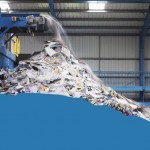Context
Talking about climate change can be dramatic, even scary (floods, fires, the apocalypse). Talking about energy (the lights going out all over town, periodically or maybe even permanently) can be exciting. Even biodiversity can be a conversation on a grand scale (the extinction of entire species, like what happened with dinosaurs). But waste? That’s another story without a lot of sex appeal.
We covered the story in our October 2010 issue of the magazine and here we doggedly catch up on developments since then as reported by EPA in EPA Licensed Sites – Report on Waste Enforcement (2015).
Type and Scope of Waste Facilities
Several basic trends, evident in the earlier report (2001–2009), are the falling number of open landfills, from 36 to 9; the continuing privatisation of the municipal solid waste (MSW) business, with now only 4 local authorities involved; and, the reduction in waste being landfilled, from 1,700 kTonnes in 2009 to 700 kTonnes in 2013. At the same time, and not coincidentally, the landfill levy charge has tripled from €25/tonne in 2009 to €75/tonne in 2013. Thanks to the increased cost, less waste is being disposed of in landfills, an instance of a price mechanism working to reduce stress on landfilling activities.
There is a growing trend in use of waste as a fuel, either as refuse derived fuel or baled municipal residual waste, with almost 400,000 tonnes in 2013. Much of this material is exported.
More generally speaking, the Irish Environmental Protection Agency (EPA) regulates a variety of waste disposal facilities, beside MSW sites, including waste transfer stations, waste incineration, composting sites, and dumping at sea. The dumping at sea is a new responsibility for EPA and is related to dredging operations at ports. There are a total of 159 active separate waste facilities. In addition, EPA and local authorities license other waste-related facilities, such as “bring banks” and other recycling collection sites.
Enforcement
In 2013, EPA set forth a number of priority areas for enforcement for landfills and transfer stations, including management of gases and leachate, odours, surface and groundwater impacts, and operational issues (e.g., cover, capping, record keeping, diversion of biodegradable waste). Of particular note was the significant number of complaints of odours, including from the facilities handling baled MSW for export. Also significant, in 2013 there were three fires at EPA licensed facilities, one in 2014, and 12 overall in “recent” years.
As an example of the level of enforcement, we can look at the largest category of waste facilities — landfills — which includes the MSW and other licensed landfill sites, with a total of 70 sites in 2013. For these 70 sites EPA conducted 111 inspections, which amounts to 1.6 per year per site, or about once every 6 months. Interesting, in our earlier report on landfills, we noted that for 36 municipal, inert and mono landfills, there were 434 audits and inspections, or 6 per site per year.
For the 70 landfill sites there were 454 reported “incidents,” which are emergencies on site or an emission not in compliance with the license or exceeding a trigger level for a pollutant. The 547 complaints EPA received for all 159 licensed sites were overwhelming about odour, with 228 odour complaints from the 70 landfill sites and 281 from non hazardous waste transfer stations, totaling 509 of the 547 (93%) of the odour complaints. Of these odour complaints, 361 of 547, or 66%, came from just 5 sites. More about these sites below.
There were 217 Notifications of Non-Compliance (NONC) which presumably grew out of the 454 “incidents” and 228 complaints, for the 70 landfill sites. Based on the complaints, NONCs issued, incidents and EPA inspections, EPA opened 44 Compliance Investigations for the 70 landfill sites.
When the discussion turns to actual enforcement actions taken, the trail for our 70 landfill sites gets lost and, for some reason, there is no tracking what happened to the 44 Compliance Investigations for the landfill sites. Instead we are only informed that the waste sector in general (and in contrast to food & drink, intensive agriculture, metals, pharma chem) is the worst for prosecutions taken, representing 40% of all cases between 2009 and 2013, even though the waste sector holds only 15% of all licenses issued.
There is a breakdown for six prosecutions taken in 2013 for the waste sector, but we cannot link them to the Compliance Investigations. Moreover, we learned earlier (Figure 9) that five waste sites in 2013 were responsible for 361 of 457 complaints for the waste sector, yet none of these repeat offenders appear on the list of sites (Table 4) that were prosecuted in 2013.
These six prosecutions in the waste sector in 2013 netted a recovery of €86,055.25. In contrast, we reported earlier of a recovery of €250,347 over 8 years for prosecution against landfills, or €31,293 per year on average. Not only has the amount of recovery for waste prosecutions seemed to have risen, but significantly in two of the six waste prosecutions in 2013, Directors of the companies involved were also prosecuted. There is no indication of the disposition of the prosecution case against the Directors. Bringing the Directors into prosecutions is a significant advancement in environmental enforcement.
Besides now targeting Directors, in the appropriate circumstances, EPA has recently started efforts to coordinate its waste enforcement efforts with those of local authorities, and is addressing the need for increased financial security for environmental liabilities at closed or abandoned waste facilities.
What Remains Unspoken
There are 59 closed landfills that require monitoring but there is little information on what level of monitoring is being taken, where, with what results, and at what cost. Experience shows us that old closed, or abandoned, landfills often come back to haunt us with significant pollution and risks and costs.
Sources
Irish Environmental Protection Agency, EPA Licensed Sites – Report on Waste Enforcement (2015). www.epa.ie/pubs/reports/enforcement/epalicensedsites-reportonwasteenforcement.html#.VT_jNBcmzKw
“Landfilling: Waste Not, Want Not,” in Reports section of irish environment (Oct 2010). www.irishenvironment.com/reports/landfilling/




No comments yet, add your own below